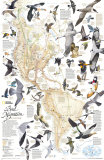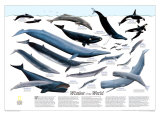|
|
Dinosaur map features:
• A physical map of the region with overlaid boundaries of states and provinces to show the area's relation to modern North America
• Information about the various types of dinosaurs found in North America
• Illustrations of the region's dinosaurs
• Inset of the continents as they existed 74 million years ago
• Notes about fossils and what they tell us
• Dinosaur fossil distribution
• Geological time scale |
|
|
|
(poster details)
A fabulous array of dinosaurs ranged across North America during the Mesozoic era. Descendants of ancient reptiles, dinosaurs had evolved as continents shifted, climates changed, and plants blossomed into modern forms. Diverse in size, shape, and behavior, dinosaurs faced no animal challenge. Yet none survived an end-of-era cataclysm. Perhaps they perished after a gigantic asteroid flung enormous amounts of pulverized rock into the atmosphere. The global cooling and darkness that likely followed are prime suspects in the snuffing out of flying reptiles, scores of marine creatures, and the lost lords of Earth.
THE CONTINENTS SHAPE UP
At the dawn of the dinosaur age, some 15 million years after the Mesozoic era began, continental plates were crowded together into the supercontinent Pangaea. After early dinosaurs established themselves throughout this landmass, the continents drifted apart. By 74 million years ago ... North America was taking its present shape. Seas, at full flood, separated the North American continent into sections and split Asia from Europe.
THE ENVIRONMENT
Great sun-warmed seas covered much of the Earth during the late Cretaceous, a time of mild climates and ice-free polar regions.Densely forested with sequoia-like trees, Alaska felt winter's chill but saw little frost.
The Western Interior Seaway, almost a thousand miles wide at times, flooded one-third of North America. The modern Gulf Coast was underwater, a huge bay spread over the confluence of the Ohio and Mississippi Rivers, and an arm of the sea stretched across the Hudson Bay area to the North Atlantic.
On land, flowering plants ancestral to magnolias, roses, oaks,and walnuts spread among the conifers, ferns, and palmlike cycads that had dominated most of the Mesozoic. Geologic pressures were thrusting up many of the world's hig hmountain ranges, including the Rockies.
LIFE IN THE INLAND SEA
Leviathans as strange as the dinosaurs on land included mosasaurs (marine lizards) such as the Tylosaurus and Platecarpus. These relatives of today's monitor lizards were top predators of the inland sea. Covered with diamond-shaped scales, they undulated their slim bodies and long, flat tails to move through the water like eels. Front fins probably enabled the animals to turn quickly, and back fins acted as stabilizers. Some Tylosaurus fossils preserve meals being digested: fish, flightless swimming birds, and even other mosasaurs.
Mosasaurs also ate giant squid and a now extinct class of spiral-shelled mollusks called ammonites–and left bite marks still visible on fossilized remains.
Fish swallowed squid whole: One eight-foot specimen ate such a large squid that it must hae choked to death with its victim's tentacles hanging out of its mouth. One of the largest fish ever, Xiphactinus was longer than modern swordfish. It ate a variety of other fish, and its cousin Gillicus, usually about half its size, was apparently a favorite.
Elasmosaurus, a plesiosaur (marine reptile) with no living relatives, also preyed on fish. Moving its oarlike limbs up and down to swim, it may have approached schools from below, positioning its long neck so as to attack from beneath the belly and to the rear of prey–their blindspot. Like the alligator of today it swallowed stones, perhaps for the same reasons–to grind up food in a gizzard and to provide ballast.
Largest of sea turtles, the rare Archelon most likely swam as its living relatives do, working its paddles like birds' wings.
Still missing from the fossil record are many of the smaller animals that must have supported these large marine predators.
The Rhino Dinos: CERATOPSIANS
The plant-eating ceratopsians bristled with an armory of horns and neck shields. Some, like Pachyrhinosaurus and Styracosaurus, weighed several tons and would have been formidable foes to any predator. Males' shields may also have intimidated rivals or helped attract mates.
Undisturbed, these hoof-toed quadrupeds browsed quietly in herds on open plains, snipping bunches of tough plants with their pointed, bony beaks, then chewing with scissor-like teeth.
Unlike Anchiceratops and Triceratops, the 200-pound Leptoceratops had no horns and almost no shield. Though it lived at the same time as its shielded relatives, its small size, partly bipedal gait, and clawed toes set it apart.
Along with hadrosaurs, the ceratopsians appear to have been the most numerous of the continent's dinosaurs in the late Cretaceous.
Bird Mimics: ORNITHOMIMIDS AND TROODONTIDS
Amid the other dinosaurs–the massive, the fantastically crested and horned–live smaller, streamlined creatures reminiscent of birds, dinosaurs' only living relatives. The long-necked, slightly built, leggy Dromiceiomimus belongs to the ornithomimidae (bird mimic) family. Its running speed–some 30 miles an hour, as fast as an ostrich–and keen eyesight enabled it to escape predators and perhaps to catch such quick prey as insects, small mammals, and lizards. It also probably used its toothless beak to browse on leaves, fruits, and seeds. Its light, flexible skull and neck bones allowed it to maneuver food into its mouth with great speed and precision.
Troodon, from a different family, developed similar body lines as well as a brain whose relative size matches those of some modern birds and mammals. This speedy carnivore, with opposable digits on its hands, probably hunted a variety of small animals. Many of its saw-edged teeth have been found in hadrosaur nests, suggesting that it often fed on their young.
Flesh-eaters: TYRANNOSAURS
Striding on trunklike legs, the seven-ton Tyrannosaurus towered among the trees. Though smaller, its relative Daspletosaurus and Albertosaurus looked no less savage. All had massive heads, lethal serrated teeth, arms capablle of lifitng hungreds of pounds, sharp claws on birdlike feet and on two-fingered hands.
Were these–the biggest of all carnivores–terrifying predators, lumbering carrion feeders, or something of both? Some experts believe that Tyrannosaurus ambushed prey, slamming its open jaws into unprotected flesh. Others think that the hands could have held prey like a meat hook while the jaws did their deadly work. Perhaps the feet dealt crippling kicks. In shared hunting grounds Daspletosaurus might have stalked the horned ceratopsians, while the slighter Albertosaurus took off after bipedal hadrosaurs.
Carcasses of animals felled by accident or nature may have supplemented the tyrannosaurs' hunting–or made up their entire diets if they were not agile enough to bring down prey themselves.
Duckbills and Boneheads: HADROSAURS AND PACHYCEPHALOSAURS
Hoots, honks, and bellows of the bipedal hadrosaurs may have run across lowland plains and meandering rivers like the sounds of a noisy zoo. The hollow crests of Parasaurolophus, Lambeosaurus, and Corythosaurus probably resonated their calls. Though otherwise similar to these animals, Saurolophus had a solid crest, and Edmontosaurus none at all.
Crests and calls could have been mating displays. After mating, females likely nested in colonies and tended their broods after hatching.
Hadrosaurs cropped twigs, pine needles, leaves, and seeds with a wid toothless beak, which has given them the nickname “duckbills.” Banks of as many as 2,000 rasping teeth chewed thoroughly.
Another group of herding herbivores, pachycephalosaurs such as Stygimoloch and Pachycephalosaurus, roamed upland areas. Males may have butted their thickboned, domed heads to establish dominance and win mates.
Fossilized impression of some dinosaurs' skin reveal texture, but their coloring is always fanciful.
Giants Among Giants: SAUROPODS
Enormous in its own time, the 30-ton Alamosaurus was a dwarf compared with earlier sauropods, which may have reached a hundred tons. A herbivore, Alamosaurus probably browsed through forests and moved to new feeding grounds in herds, the adults protecting the young. Its sheer mass must have deterred most predators, but it could also lash out with its long tail or slash out with the large curved claw on each elephantine foot. Some scientists suggest that Alamosaurus may have reared up and crushed attackers with its massive legs.
The Tanks: ANKYLOSAURS
Intimidating ankylosaurs wore bone-plated armor primarily for defense–they were peaceful plant-eaters. The heavyset browsers belonged to two families: Ankylosauridae, with heavy clubs at the end of their tails, and Nodosauridae, without. Edmontonia, one of the last of North America's Nodosauridae, probably hunkered down and waited for a predator to retreat. Euoplocephalus, the most common of North America's Ankylosauridae, could have clobbered an attacker's legs with its tail club. Bony eyelids gave extra protection. At two and a half tons, it weighed almost half as much as an African elephant.













